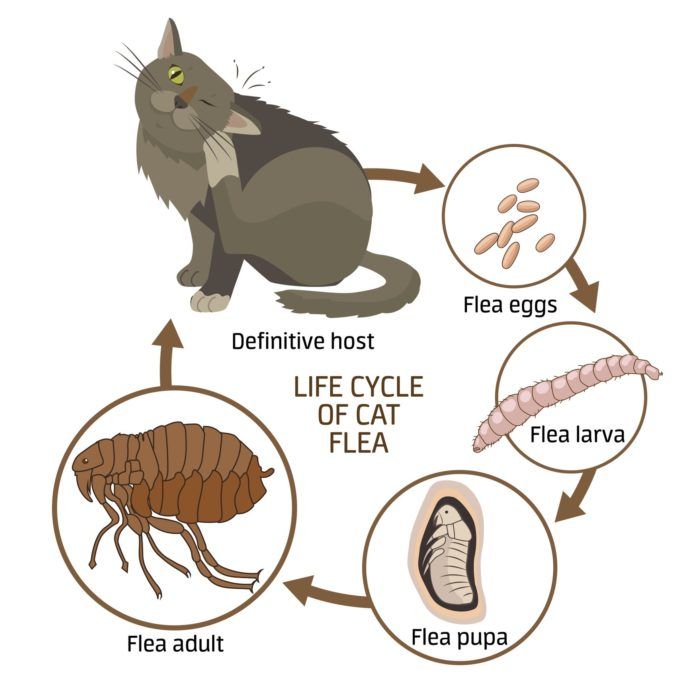The question remains: What’s the best flea treatment for my home? Well, researchers discovered that in a typical flea-infested house, the adult fleas represent only about one to five percent of the flea population! So where are the rest of the pests? Flea eggs make up about 50 to nearly 60 percent, flea larvae makes up about 35 percent, and the pupae (a life stage of the flea that comes after larvae and before emergence as an adult) about 10 percent.
In short, the best flea treatment for your home means taking on the adults and the other life stages. Because the eggs, larvae, and pupae all have the potential for turning into fleas, destroying the insects in the non-adult stages is critical to preventing the population from repeatedly bouncing back into your, and your cat’s, environment. It will probably take a patient and ongoing approach to tackle the problem.
Kill Fleas in Carpet and Rugs
A powerful vacuum with a rotating brush is a powerful tool in killing fleas in carpets and rugs. Frequently vacuuming the areas where our cats hang out indoors can remove a lot of flea eggs – the eggs cannot survive the physical trauma of being vacuumed. The thicker or deeper your carpets are, however, the more difficult it will be to vacuum up all the flea eggs. Vacuum every two to three days for best results, and throw away the bag each time you vacuum. Be sure to sweep and mop tile and wood flooring, too.
Flea eggs can survive being wet, but being washed in hot water and detergent (which can penetrate the egg’s outer “skin”) can also kill flea eggs. Time spent in a hot clothes dryer is an effective way to kill flea eggs. It’s a good idea to put easy-to-wash blankets or towels in areas where your cat likes to sleep. This will make the flea clean-up much simpler when there are fleas in the home.
There are various carpet powders and flea sprays for the home on the market, but be sure that they are safe to use around children and other pets, like birds and fish.
A variety of flea-control products are available to cat owners. Some are applied to the skin on the back of the neck, whereas others are oral flea control products. Speak with your veterinarian about your cat’s environment and what type might work best. Remember that you should never give flea-tick medication meant for dogs to your cat. The results can be fatal.
“If you still see them around your cat after having given her a good anti-flea medication, you probably have a reinfestation rather than a case of resistance to the product,” says Tufts veterinary dermatologist Luis Ferrer, DVM, PhD, DECVD. Keep in mind that none of this means you are a dirty or a bad housekeeper – instead, it means you need to take extra steps to eradicate the problem. It might even require professional flea treatment for your house.
Certainly, the risk of having fleas is much higher in outdoor or outdoor-indoor pets that in exclusively indoor pets. However, indoor cats and dogs can also get fleas. Humans and visiting pets can occasionally introduce fleas into the household. The introduction of a new pet can also be the way that fleas find their way into your house.





Thanks for the flea information ! I’ve used a mixture of baking soda & salt on my carpets , leave it for a day & then vacuum. It’s supposed to kill fleas
Yes! I’m with Bobbie on her use of baking soda. It works. It really works. My 2 cats are often on my bad napping or looking out the window. I spread a very thin layer of baking soda on the bottom sheet. This will kill and deter fleas and other crawling and flying pests. I also sprinkle it on the carpets the night or day before I vacuum. I haven’t used salt with the baking soda though. I’ll keep it in mind if I get a worse-than-normal infestation.
I use baking soda and vinegar for cleaning just about every other surface in the house. If you’re not sure that it’ll be safe, just spot test it. Spread a thin (or thick) layer of baking soda on a surface and then spritz or pour the vinegar on top of it. This has a disinfecting effect. You’ll see it bubble up as it’s working..
These methods were very useful during COVID outbreaks as an extra layer of disinfection. The baking soda, vinegar and salt will stay effective for several days, so you can let it sit until you have time to pick it up. But it can get messy if you add vinegar or water to it. For me, it’s worth the extra protection (and savings).
And….baking soda, salt, and vinegar are cheap, very cheap!
This article is a lifesaver for cat owners dealing with fleas! The step-by-step approach to eliminating fleas from both your pet and your home is super practical. I appreciate the reminder that thorough cleaning and consistent prevention are key to breaking the flea life cycle. Thanks for such a helpful and informative guide!